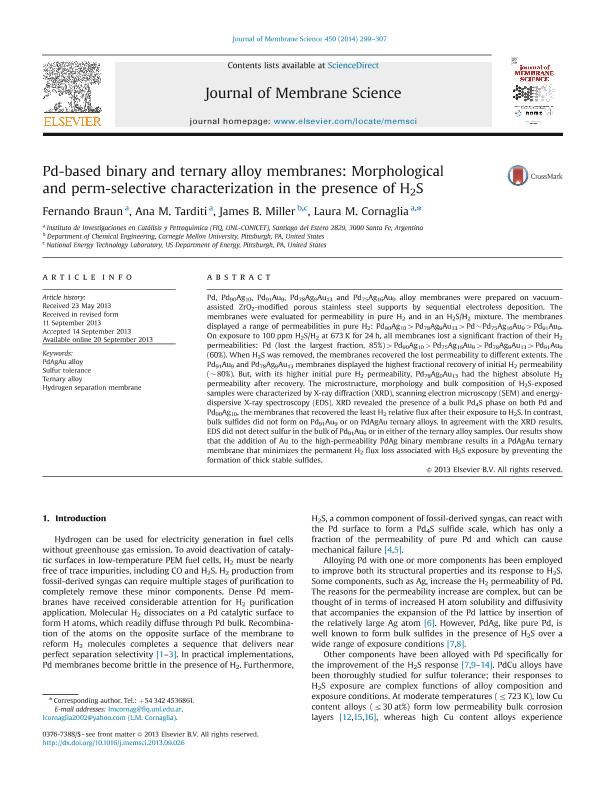Artículo
Pd-based binary and ternary alloy membranes: Morphological and perm-selective characterization in the presence of H2S
Fecha de publicación:
09/2013
Editorial:
Elsevier
Revista:
Journal of Membrane Science
ISSN:
0376-7388
Idioma:
Inglés
Tipo de recurso:
Artículo publicado
Clasificación temática:
Resumen
Pd, Pd90Ag10, Pd91Au9, Pd78Ag9Au13 and Pd75Ag16Au9 alloy membranes were prepared on vacuum-assisted ZrO2-modified porous stainless steel supports by sequential electroless deposition. The membranes were evaluated for permeability in pure H2 and in an H2S/H2 mixture. The membranes displayed a range of permeabilities in pure H2: Pd90Ag10>Pd78Ag9Au13>Pd~Pd75Ag16Au9>Pd91Au9. On exposure to 100 ppm H2S/H2 at 673 K for 24 h, all membranes lost a significant fraction of their H2 permeabilities: Pd (lost the largest fraction, 85%)>Pd90Ag10>Pd75Ag16Au9>Pd78Ag9Au13>Pd91Au9 (60%). When H2S was removed, the membranes recovered the lost permeability to different extents. The Pd91Au9 and Pd78Ag9Au13 membranes displayed the highest fractional recovery of initial H2 permeability (~80%). But, with its higher initial pure H2 permeability, Pd78Ag9Au13 had the highest absolute H2 permeability after recovery. The microstructure, morphology and bulk composition of H2S-exposed samples were characterized by X-ray diffraction (XRD), scanning electron microscopy (SEM) and energy-dispersive X-ray spectroscopy (EDS). XRD revealed the presence of a bulk Pd4S phase on both Pd and Pd90Ag10, the membranes that recovered the least H2 relative flux after their exposure to H2S. In contrast, bulk sulfides did not form on Pd91Au9 or on PdAgAu ternary alloys. In agreement with the XRD results, EDS did not detect sulfur in the bulk of Pd91Au9 or in either of the ternary alloy samples. Our results show that the addition of Au to the high-permeability PdAg binary membrane results in a PdAgAu ternary membrane that minimizes the permanent H2 flux loss associated with H2S exposure by preventing the formation of thick stable sulfides.
Archivos asociados
Licencia
Identificadores
Colecciones
Articulos(INCAPE)
Articulos de INST.DE INVEST.EN CATALISIS Y PETROQUIMICA "ING. JOSE MIGUEL PARERA"
Articulos de INST.DE INVEST.EN CATALISIS Y PETROQUIMICA "ING. JOSE MIGUEL PARERA"
Citación
Cornaglia, Laura Maria; Miller, James B.; Tarditi, Ana Maria; Braun, Fernando; Pd-based binary and ternary alloy membranes: Morphological and perm-selective characterization in the presence of H2S; Elsevier; Journal of Membrane Science; 450; 9-2013; 299-307
Compartir
Altmétricas




